WW2 Mountain Stove ALADDIN 1945 and the RARE Mtn Cookset, Spare Parts, Wrench
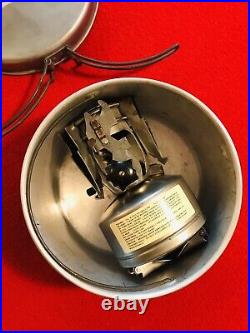
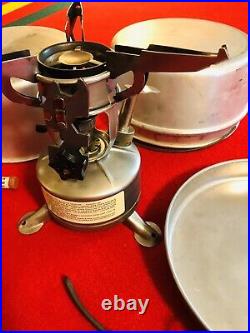
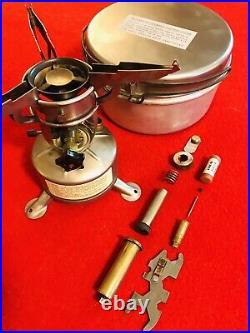
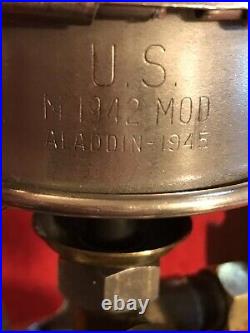
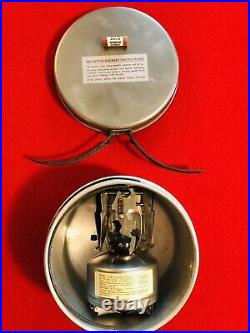
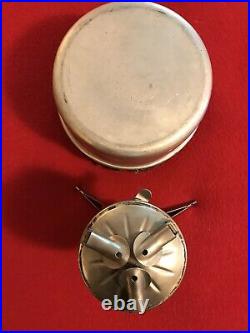
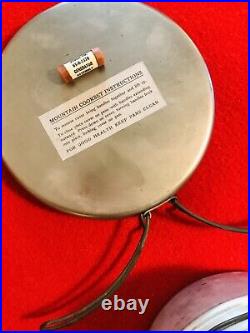
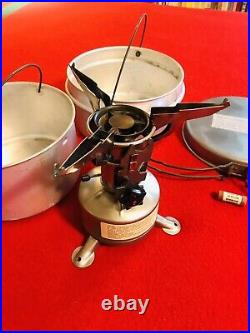
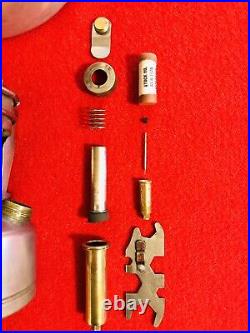
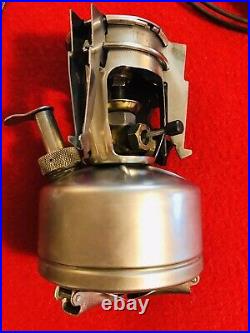
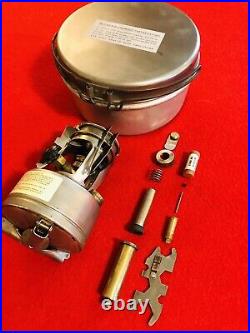
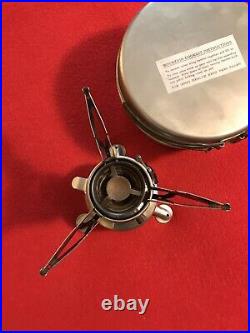

And the RARE wartime-dated 3-Piece "MOUNTAIN COOK SET"!! Legibly stamped on the WINDSCREEN of the Stove , U.
Legibly stamped on the bottom of the larger of the two. This COMPLETE assemblage is in NEAR MINT+++ condition!!
This STOVE was well cared for! Initially designed by the redoubtable Bestor Robinson and Robert Bates, American alpinists, for use by the Mountain/Ski troops above treeline and for use inside the Army's proprietary (Reversible White Snow Camouflage / OD) Mountain Tents, this versatile, light-weight, compact " M1942-Modified" model made its way through the QMC supply system to Armored personnel, Airborne troops, Rangers , even to the U. And any "foxhole chef" who could lay his hand on one of these. When you gotta have coffee... This has the knurled NICKEL-ED Fuel CAP -- unique to the ALADDIN models -- and it is free of corrosion and threads on smoothly.
The Multi-purpose WRENCH which locks onto the WINDSCREEN i s present. The BRASS PUMP ASSEMBLY of BRIGHT gleaming Brass and is free of tarnishing, scratches or damage of any sort.
The Leather PLUNGER CUP is supple with no cracking or tears. Swing into place and lock securely. There is ZERO corrosion, significant'dents,' or scratches to the Stainless Steel TANK; virtually NO Heat Discoloration to the Pot Support ARMS ; ZERO scratches or damage to the Black "Bakelite" CONTROL KNOB or the Wooden KNOB of the CLEANING NEEDLE. There are two (2) SPARE GENERATORS and the Packing GASKET: one is stored in the PUMP, plus there is a second NOS (New Old Stock) Generator, Stock No. The Pale Yellow " INSTRUCTIONAL DECAL" detailing the operation of the Stove is an exact FACSIMILE REPLICA of the ORIGINAL which rarely survived more than several exposures to HEAT and FUEL.
Of the the seven manufacture/year variants of the Mountain Stove, next to the "Wheel" model this ALADDIN 1945" is SCARCER than half of ALL of the "MODIFIED M1942 Stoves! Here they are listed in ascending order of RARITY. 1943 Aladdin, M-1942 "WHEEL" (least common). Included also is the very RARELY encountered " 1945-WARTIME-DATED" Aluminum and Steel 3-Piece "MOUNTAIN COOK SET" from the Republic Stamping and Enameling Company, one of LESS frequently encountered of the several contractors who made this set. The M1942 STOVE fit PERFECTLY inside the nested STOVE POTS!
Republic Stamping and Enameling of Canton, Ohio was a leading innovator of enamelware and was awarded numerous contracts from the War Department for Canteens, Cups, and various articles of Cookware. This " MOUNTAIN COOK SET" was the'preferred' piece of culinary/mess equipment of the troops who were issued the M1942 Stove. It took up only slightly more space in a RUCKSACK, but prov ided more pieces of Cookware! This was vastly superior to the smaller 2-piece STORAGE CANISTER/COOKING SET with the'F-Bayonet' Closure.One STEEL LID/ FRYING PAN with Folding/Locking Plated-IRON WIRE Handles. One Smaller ALUMINUM Cooking POT , with Plated-IRON WIRE Handles.
One Larger ALUMINUM Cooking PO T, with Plated-IRON WIRE Handles. Minor "dings " to the two POTS a nd some aluminum oxide spotting on the outside of the smaller Pot and inside of the larger Pot. NOTE: The 4" x 1-3/4" Paper " MOUNTAIN COOK SET INSTRUCTIONS" Label glued to the Lid with details regarding the care and cleaning of the set is an exact FACSIMILE REPLICA of the ORIGINAL which did not survive more than ONE use of the Frying Pan Lid... And the exposure to flames! To remove cover bring handles together and lift up.
To close place cover on pans with handles extending outward. Press down on cover, turning handles back into place, locking cover on pan. FOR GOOD HEALTH KEEP PANS CLEAN. ALADDIN (The Mantle Lamp Company of Chicago, established in 1908) was one of three contractors of this improved "M1942 - MODIFIED" Stove. (1) Coleman Appliance who only produced stoves in 1944. (3) Aladdin, 1944, 1945 production years. But ONLY ALADDIN produced a model in 1944, the first of production of this "MODIFIED" Stove, that did NOT have the designation of M-1942-MOD. Stamped into the Steel Windscreen, but which WAS added on this 1945-production-year Aladdin. History of Aladdin Lamp Company.Nearly a century ago, a very small boy on a Nebraska farm read and re-read the Arabian Nights story of Aladdin in a room of darkness but for the flickering yellow light of an open flame coal oil lamp. Several years later that boy, grown to manhood, found a lamp that erased the darkness with a soft white light and it was only natural that he named the lamp Aladdin. An appropriate name, indeed, for this revolutionary boon to rural America seemed nothing short of magical in the intensity of its light. For those who lit the lamp, trimmed its wick and cleaned its chimney, or just enjoyed its friendly glow, the Aladdin lamp recalls many memories of golden childhood. It made learning possible for many boys and girls; made it possible for them to acquire knowledge that helped them realize their dreams and aspirations.
Later, Aladdin brought this white light to every kind of habitat in every corner of the globe. For many, it has been the only light of their entire life. Even when electricity comes, there are a loyal few who profess to use the electric light only to find the match to light their Aladdin. Victor Johnson founded the Mantle Lamp Company of America in Chicago in 1908 and imported the Practicus incandescent burner from Germany. In 1926 Johnson bought the Lippincott Glass factory in Alexandria, Indiana to make glass lamps, chimneys and shades, changing the name to Aladdin Industries. WWII played a significant role in the history of Aladdin lamps.As the war effort intensified, electric lamps were temporarily discontinued by 1943. Aladdin was granted permission to use copper by the War Production Board , because the use of Aladdin kerosene lamps reduced the need for copper wire to electrify homes.
Agents were recruited to sell lamps throughout the country and farm land. They demonstrated the Aladdin and often left the lamp in the home for an overnight trial. The agent arranged for local merchants to stock supplies. In 1928 the company turned solely to franchise dealerssome 15,000 in the early 1930s.
The company advertised extensively in newspapers and through radio. Aladdin lamps were made in the USA until 1963, after which brass lamps were imported from England. Only the glass lamps continued to be made in the USA. Since 1977 the Aladdin burners have been manufactured in Hong Kong while the fonts are made in the USA and England. Chimneys, wicks and mantles are made in other countries today.
In June 1942 the Army Quartermaster Corps issued an urgent request : field troops needed a compact stove that could operate at 125 degrees above and 60 degrees below zero, was no larger than a quart bottle of milk, and could burn any kind of fuel. Moreover, the Army wanted 5,000 of the stoves delivered in two months. The end product was better than the Army had requested: the stove could function at 60 degrees below and 150 degrees above Fahrenheit; it could burn all kinds of fuel; it weighed a mere three and one-half pounds; and it was smaller than a quart bottle of milk. The first order for 5,000 units was flown to U.
Forces involved in the November 1942 invasion of North Africa. Ernie Pyle, the famous World War II journalist who wrote about the common man's experience in the war, devoted 15 articles to this compact "single-burner pocket stove" and considered it one of the two most important pieces of noncombat equipment in the war effort, the other being the Jeep! From the exceptional summary, " SklColorado: Steve's Life in Colorado".By the time the Africa campaign began in 1942, construction of Camp Hale in Colorado, was pretty much completed and U. Ski troopers were being trained in skiing, climbing, winter survival and ordinance. Camp Hale eventually became known for its 10th Mountain Division.
Somewhere, in this same time-frame, Bestor Robinson , a lawyer, mountaineer and director of the Sierra Club in California prior to WWII, was assigned to a team at the U. Army's Office of the Quartermaster General with the role of improving clothing and equipment for the Army's mountain divisions. The team was led by Robert Bates , who was an avid mountaineer, and it's worth reading his short bio!
During this time Robinson was granted patents for the design of a compact stove, which is regularly called the "mountain stove" by many today. His patent designs for the stove and various parts of it can be found by searching the web for these numbers: Patent No. The contract to build the new little stove was awarded to the Aladdin Industries subsidiary of The Mantle Lamp Company of America or Mantle Lamp themselves, and manufactured under the name Aladdin , similar to the parent company's well-known lamps. It's kind of confusing exactly who made it, since The Mantle Lamp Company made Aladdin lamps, and they had a subsidiary with the same name, plus, Mantle Lamp eventually merged with Aladdin. Aladdin is still in business today.
You may be familiar with some of their products which sell under the Stanley vacuum bottle name and other food and beverage containers. The first model of the stove is commonly called the wheel stove , by many collectors, because of the horizontal wheel used to operate the stove's burner. My understanding is that the wheel design was to allow troopers to operate the stove in cold weather without removing their gloves or mittens. This model was only made by Aladdin and only in 1943.For reasons unknown to me, the stove was modified from the wheel design to one somewhat more conventional after only one year, particularly in the valve stem. This second stove model is known, and is stamped, as the M-1942 MOD , where'MOD' denotes'modified. The model was also produced by Aladdin in 1944, and Prentiss-Wabers a. Known as Preway of Wisconsin Rapids, Wisconsin and possibly by one other company (possibly Coleman), however, I have been unable to confirm this. In 1945, the M-1942 MOD was produced by Aladdin, Prentiss Wabers and Coleman.
Coincidentally, Aladdin and AGM/Thermos ended up in court over the right to manufacture vacuum bottles in the late 1950s. It seems that the term thermos became a generic name, much the same way that the word Kleenex is used instead of facial tissue, or when Xerox was a generic term for making a duplicate paper copy. I've never seen manufacturing year stamps past 1945, so it appears that the stove was very short-lived with a production run of only three years; one year being the wheel stove and two years as the MOD-ified stove. The 1943 wheel stove is rather rare and is often found badly rusted since Stainless Steel was not used in its fabrication.
What gives this stove such a long life, is that it is mostly stainless steel and brass. Unlike other stoves of the same era, which have steel founts (tanks), steel pot-support/burner frames, and steel tip-cleaner stems, this stove doesn't get destroyed by rust.
However, I've worked on two 1943, M-1942 "Wheel" Stoves , which is the early model, and it is not made of stainless steel and can have rust in places where the zinc has worn off. The stove itself is a good design and I've found it reliable and enjoyable to use. The tank is stainless steel and I've never seen the M-1942 MOD with rust in it or on it.
It will typically need a good cleaning, especially because it was designed to run on regular gasoline and was regularly used with that fuel. The gasoline will leave sediment in the tank and generally clog the vaporizer screen. It had a spirit cup for pre-heating the vaporizer a. Generator, folding feet, folding pot support arms, and an 8 ounce tank.
Robert Bates, contributor to the design of the M-1942- MOD. Stove and other WWII U. Bates was born in Philadelphia and was the son of William Bates, a classical scholar at the University of Pennsylvania. He briefly attended the William Penn Charter School , and then Phillips Exeter Academy.He attended Harvard University from 1929 to 1935. At Harvard he was a member of the Harvard Mountaineering Club and with Charles Houston, Adams Carter, Bradford Washburn and Terris Moore was part of the group of climbers later known as the "Harvard Five" who would push forward the standards of American mountaineering in the 1930s. In 1937 Bates, with Bradford Washburn, made the first ascent of Mount Lucania in Yukon, which was then the highest unclimbed mountain in North America.
It was also one of the most remote and inaccessible and had been declared "virtually impregnable". The pair enlisted the aid of the pilot Robert Reeve to fly them to the mountain, but when they landed on the Walsh Glacier the aeroplane sank into the unexpectedly soft snow.
After they had spent five days digging it out Reeve departed, warning Bates and Washburn that he would not be able to return to collect them as planned and that they would have to walk back to civilization. The pair climbed Mount Lucania , and the nearby Mount Steele, and were then faced with a 100-mile (160 km) trek through wilderness to Burwash Landing , without maps.They abandoned some of their food to save weight, expecting to restock at a cache left behind by an earlier expedition. However, the cache had been plundered by bears, and Bates and Washburn survived on mushrooms and squirrels during the trek out. Flooded rivers forced them to detour many miles out of their way, and they had eventually walked an estimated 156 miles by the time they reached Burwash Landing , 32 days after arriving on the glacier.
The two men lost around twenty pounds each during the walk out. In 1937, Charles Houston invited Bates on an expedition to K2 for 1938, the world's second highest mountain. It was the first expedition to the mountain for nineteen years, and while the focus was on reconnaissance and assessing the feasibility of different routes, Bates was part of a group which reached within 800 m of the summit on the Abruzzi Spur , which would become the preferred route on the mountain. The expedition failed due to bad weather and the illness of Art Gilkey, but was widely praised for the courage shown by the team in their unsuccessful attempt to save Gilkey. During the descent, Bates and five other climbers were involved in a near-fatal fall, saved only by the strength of Pete Schoening, who was the last man on the rope.Bates later received the David A. Sowles Memorial Award for his part in the attempted rescue. During the Second World War Bates served in the United States Army and was assigned to the Office of the Quartermaster general, where he worked on the development of improved equipment and clothing for the army's mountain divisions.
He recruited a skilled wartime team that included mountaineers William P. Wood III, Bestor Robinson , H. Adams Carter, Terris Moore, Bradford Washburn and Australian arctic explorer Hubert Wilkins.He reached the rank of Lieutenant Colonel and was awarded a Bronze Star and the Legion of Merit. After the war, Bates taught English at Phillips Exeter Academy.
He continued mountaineering throughout his life, and at the age of 74 led an expedition which made the first ascent of Ulugh Muztagh in China. He also spent a year in Kathmandu directing a Peace Corps project, and served as president of the American Alpine Club , which awards the Robert Hicks Bates Award to promising young climbers in his honor. Bates was the author of several books. With Charles Houston he wrote accounts of their two K2 expeditions as Five Miles High and K2 - The Savage Mountain ; the latter being regarded as a mountaineering classic. He also wrote Mystery, Beauty, and Danger , a study of mountaineering literature, and Mountain Man: The Story of Belmore Brown , the biography of an artist and explorer.
His autobiography, The Love of Mountains Is Best , was published in 1994. The item "WW2 Mountain Stove ALADDIN 1945 and the RARE Mtn Cookset, Spare Parts, Wrench" is in sale since Friday, August 13, 2021. This item is in the category "Collectibles\Militaria\WW II (1939-45)\Original Period Items\United States\Field Gear, Equipment". The seller is "bataan12213" and is located in Little Rock, Arkansas. This item can be shipped to United States.
- Region of Origin: United States
- Modified Item: No
- Country/Region of Manufacture: United States
- Theme: Militaria
- Original/Reproduction: Original
- Conflict: WW II (1939-45)
